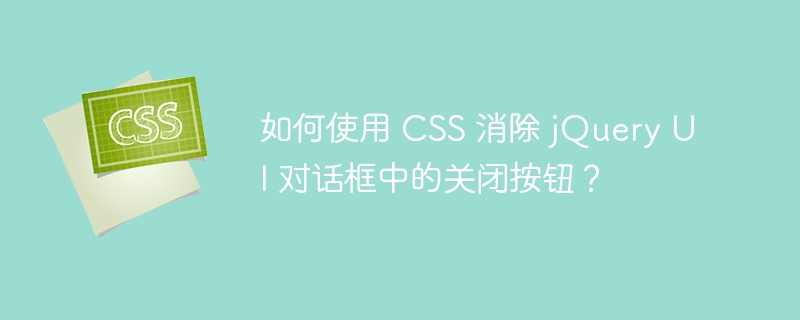How to eliminate the close button in a jQuery UI dialog using CSS?

Displaying data in sorted order in HTML web pages is a tedious task. Dialog boxes are used to display information in a presentable form in a web page. A dialog box is a floatable window that contains a title and content. jQuery UI enables developers to create simple and user-friendly dialog boxes for websites. In this article, we will discuss how to create jQuery UI dialog boxes and how to eliminate the close button in these boxes.
First, let us understand the jQuery UI dialog box.
jQuery UI Dialog
jQuery Dialog() method enables developers to create a simple dialog window in the viewport that is not affected by the content of the page. dialog() Method is used to tell the browser that any HTML element can be displayed in the form of a dialog box. It consists of title bar and content space. By default, it can be moved, resized, and deleted via the close button (x).
grammar
$(selector, context).dialog (options);
parameter
Title− It enables the developer to decide the title displayed in the dialog box.
Width- It enables the developer to decide the width of the dialog box.
Position - It enables the developer to decide the initial position of the dialog box.
Height - It enables the developer to decide the height of the dialog box.
Button - Used to add buttons to the dialog box.
Max-height - Determines the maximum height of the dialog box
Max-width - Determines the maximum width of the dialog box
Min-height - Determines the minimum height of the dialog box
Min-width - Determine the minimum width of the dialog box
Appendto - When this option is set to false, it enables us to prevent the UIdraggable class from being added to the list of HTML DOM elements.
Auto-open - When this option is left true, the dialog box will open immediately after creation. If false, a dialog box will be opened when called.
Steps to follow
Here are the steps you should follow to create a JQuery dialog box.
Step 1 - Add jQuery and jQuery UI CDN to the code inside the

Hot AI Tools

Undresser.AI Undress
AI-powered app for creating realistic nude photos

AI Clothes Remover
Online AI tool for removing clothes from photos.

Undress AI Tool
Undress images for free

Clothoff.io
AI clothes remover

AI Hentai Generator
Generate AI Hentai for free.

Hot Article

Hot Tools

Notepad++7.3.1
Easy-to-use and free code editor

SublimeText3 Chinese version
Chinese version, very easy to use

Zend Studio 13.0.1
Powerful PHP integrated development environment

Dreamweaver CS6
Visual web development tools

SublimeText3 Mac version
God-level code editing software (SublimeText3)

Hot Topics
 1378
1378
 52
52
 Making Your First Custom Svelte Transition
Mar 15, 2025 am 11:08 AM
Making Your First Custom Svelte Transition
Mar 15, 2025 am 11:08 AM
The Svelte transition API provides a way to animate components when they enter or leave the document, including custom Svelte transitions.
 Working With GraphQL Caching
Mar 19, 2025 am 09:36 AM
Working With GraphQL Caching
Mar 19, 2025 am 09:36 AM
If you’ve recently started working with GraphQL, or reviewed its pros and cons, you’ve no doubt heard things like “GraphQL doesn’t support caching” or
 Show, Don't Tell
Mar 16, 2025 am 11:49 AM
Show, Don't Tell
Mar 16, 2025 am 11:49 AM
How much time do you spend designing the content presentation for your websites? When you write a new blog post or create a new page, are you thinking about
 Building an Ethereum app using Redwood.js and Fauna
Mar 28, 2025 am 09:18 AM
Building an Ethereum app using Redwood.js and Fauna
Mar 28, 2025 am 09:18 AM
With the recent climb of Bitcoin’s price over 20k $USD, and to it recently breaking 30k, I thought it’s worth taking a deep dive back into creating Ethereum
 Creating Your Own Bragdoc With Eleventy
Mar 18, 2025 am 11:23 AM
Creating Your Own Bragdoc With Eleventy
Mar 18, 2025 am 11:23 AM
No matter what stage you’re at as a developer, the tasks we complete—whether big or small—make a huge impact in our personal and professional growth.
 Vue 3
Apr 02, 2025 pm 06:32 PM
Vue 3
Apr 02, 2025 pm 06:32 PM
It's out! Congrats to the Vue team for getting it done, I know it was a massive effort and a long time coming. All new docs, as well.
 A bit on ci/cd
Apr 02, 2025 pm 06:21 PM
A bit on ci/cd
Apr 02, 2025 pm 06:21 PM
I'd say "website" fits better than "mobile app" but I like this framing from Max Lynch:
 Let's use (X, X, X, X) for talking about specificity
Mar 24, 2025 am 10:37 AM
Let's use (X, X, X, X) for talking about specificity
Mar 24, 2025 am 10:37 AM
I was just chatting with Eric Meyer the other day and I remembered an Eric Meyer story from my formative years. I wrote a blog post about CSS specificity, and




